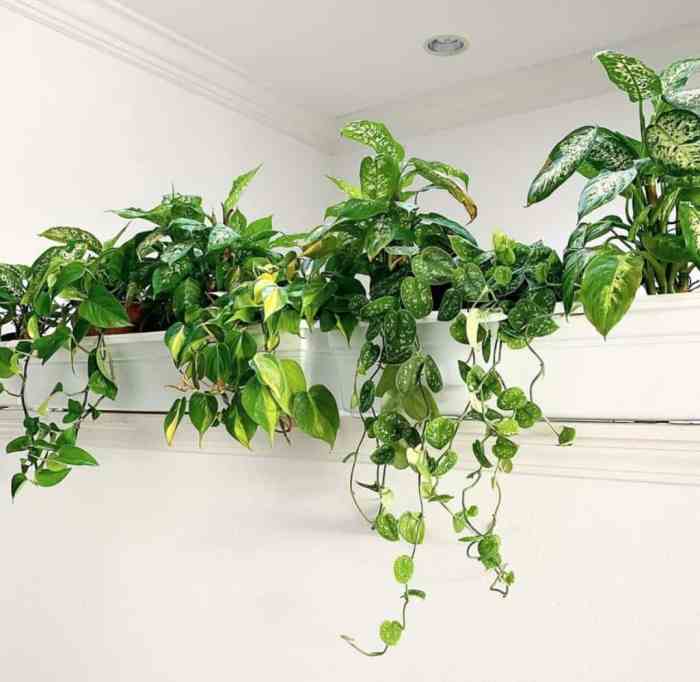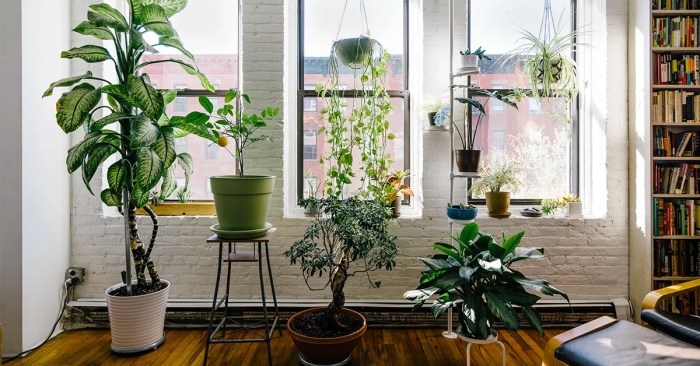Best hanging plants for living room – Transform your living room into a vibrant oasis with the best hanging plants. From lush ferns to trailing vines, these botanical wonders add a touch of nature, purify the air, and create a serene ambiance.
Discover the benefits, care tips, and design ideas for incorporating hanging plants into your living space, and explore a curated list of recommended species that will thrive in your indoor haven.
Types of Hanging Plants for Living Rooms
Hanging plants can add a touch of greenery and life to your living room. They come in a variety of types, each with its own unique growth habits, light requirements, and watering needs. Here are some of the most popular types of hanging plants for living rooms:
Spider Plants
- Spider plants are easy to care for and can tolerate a wide range of light conditions.
- They produce long, trailing stems with small, variegated leaves.
- Spider plants are also known for their ability to produce “spiderettes,” which are small plantlets that can be easily propagated.
Pothos, Best hanging plants for living room
- Pothos is another easy-care hanging plant that is tolerant of low light conditions.
- It has long, trailing vines with heart-shaped leaves that come in a variety of colors, including green, yellow, and white.
- Pothos is a fast-growing plant that can quickly fill a space.
String of Pearls
- String of pearls is a unique hanging plant that has long, trailing stems with small, round leaves that resemble pearls.
- It prefers bright, indirect light and should be allowed to dry out between waterings.
- String of pearls is a slow-growing plant, but it can eventually reach several feet in length.
Benefits of Hanging Plants in Living Rooms

Hanging plants have become increasingly popular in living room decor, not only for their aesthetic appeal but also for their numerous functional benefits. Incorporating these lush additions into your living space can significantly enhance its ambiance and well-being.
Aesthetic Benefits
Hanging plants add a touch of greenery and vibrancy to any living room. Their cascading foliage and intricate patterns create visual interest and depth, breaking up monotonous walls and adding color and texture to the space. They can complement various decor styles, from bohemian to modern, bringing a touch of nature indoors.
Functional Benefits
Beyond their aesthetic appeal, hanging plants offer several functional advantages:
- Improved Air Quality:Plants naturally absorb pollutants from the air, such as formaldehyde, benzene, and trichloroethylene. This can help improve indoor air quality, reducing respiratory problems and creating a healthier living environment.
- Increased Humidity:Plants release moisture into the air through transpiration, which can increase humidity levels in the room. This is especially beneficial in dry climates or during winter when heating systems can make the air drier.
- Reduced Stress:Studies have shown that being around plants can reduce stress levels and promote relaxation. The calming effect of greenery can create a more tranquil atmosphere in your living room, making it a more enjoyable space to unwind.
Hanging Plant Care and Maintenance
Maintaining hanging plants in living rooms requires proper care and maintenance to ensure their health and aesthetic appeal. This involves understanding their watering schedules, fertilization techniques, and pest control measures.
Watering Schedules:
- Most hanging plants prefer consistently moist soil, but not soggy.
- Water when the top inch of soil feels dry to the touch.
- Water thoroughly, allowing excess water to drain from the pot.
Fertilization Techniques:
Among the top choices for best hanging plants for living room, one cannot overlook the classic Pothos or the trailing Philodendron. These low-maintenance plants add a touch of greenery and freshness to any space. For those seeking a touch of elegance, the String of Pearls or the delicate Maidenhair Fern are excellent options.
However, if you’re looking for the best hanging plant for kitchen , consider the Spider Plant or the Peperomia, known for their air-purifying qualities and ability to thrive in humid environments. Back to the living room, the dramatic Monstera Deliciosa or the cascading Tradescantia are sure to make a statement, bringing a sense of the outdoors in.
- Fertilize hanging plants monthly during the growing season (spring and summer).
- Use a balanced liquid fertilizer diluted to half strength.
- Apply fertilizer to the soil, avoiding the leaves.
Pest Control Measures:
- Inspect hanging plants regularly for pests, such as aphids, spider mites, or mealybugs.
- Treat infestations promptly using insecticidal soap or neem oil.
- Keep plants clean by wiping down leaves with a damp cloth.
Designing with Hanging Plants
Incorporating hanging plants into living room designs can elevate the ambiance and bring a touch of nature indoors. By strategically placing plants, coordinating colors, and creating focal points, homeowners can transform their living spaces into vibrant and inviting havens.
Plant Placement
The placement of hanging plants is crucial for maximizing their aesthetic impact. Suspend plants from the ceiling at varying heights to create a dynamic display. Consider the size and shape of the plants when choosing their placement. Larger plants can be hung near the center of the room to draw attention, while smaller plants can be placed in corners or above furniture to add subtle touches of greenery.
Color Coordination
The colors of hanging plants can significantly influence the overall ambiance of the living room. Choose plants with foliage that complements the existing color scheme or adds a splash of contrast. For a harmonious look, select plants with leaves in shades of green that blend seamlessly with the surroundings.
Hanging plants are a great way to add life and color to your living room. For a lush and cascading effect, consider best draping houseplants like the String of Pearls or Burro’s Tail. These plants have long, trailing stems that will create a dramatic focal point in your room.
When choosing hanging plants for your living room, consider the amount of light you have available and the size of your space. With a little care and attention, your hanging plants will thrive and add beauty to your home for years to come.
Alternatively, for a bold statement, opt for plants with vibrant blooms or variegated leaves that create visual interest.
Focal Points
Hanging plants can serve as focal points in the living room. Suspend a large, eye-catching plant from the ceiling above a seating area to create a cozy and inviting atmosphere. Alternatively, group several smaller plants together and hang them at different heights to form a cascading arrangement that draws the eye upward.
When searching for the best hanging plants for your living room, it’s important to consider the amount of natural light available. For those with limited light, a bedroom wall planter can be a great option. Wall planters can be placed in areas with indirect light, making them ideal for hallways or rooms with north-facing windows.
As you select the best hanging plants for your living room, remember to choose varieties that complement your decor and provide the necessary ambiance.
By incorporating hanging plants as focal points, homeowners can create areas of interest that enhance the overall design of the living room.
Recommended Hanging Plants for Living Rooms
When selecting hanging plants for living rooms, consider factors such as lighting conditions, growth habits, and aesthetics. Various species offer unique appearances, growth patterns, and special features, making them suitable for different living room environments.
The following table provides a selection of recommended hanging plants for living rooms, along with their key characteristics:
| Plant Name | Appearance | Growth Characteristics | Unique Features |
|---|---|---|---|
| Pothos (Epipremnum aureum) | Trailing vines with heart-shaped leaves in various shades of green, yellow, and white | Fast-growing and low-maintenance; prefers bright indirect light | Air-purifying qualities |
| Spider Plant (Chlorophytum comosum) | Arching leaves with white or green stripes; produces spiderettes (baby plants) | Adaptable to various light conditions; easy to propagate | Air-purifying qualities; non-toxic to pets |
| String of Pearls (Senecio rowleyanus) | Trailing succulent with round, bead-like leaves | Slow-growing; prefers bright indirect light or filtered sunlight | Unique appearance; drought-tolerant |
| Burro’s Tail (Sedum morganianum) | Trailing succulent with plump, cylindrical leaves | Fast-growing; prefers bright indirect light | Unique appearance; drought-tolerant |
| Air Plant (Tillandsia spp.) | Epiphytic plants that absorb moisture and nutrients from the air | Low-maintenance; do not require soil | Various shapes and sizes; air-purifying qualities |
Final Review: Best Hanging Plants For Living Room

Embrace the transformative power of hanging plants for your living room. With their aesthetic charm and functional benefits, they not only enhance the decor but also contribute to a healthier and more inviting atmosphere.
Quick FAQs
What are the best hanging plants for low-light conditions?
Spider plants, Pothos, and ZZ plants thrive in low-light environments.
How often should I water hanging plants?
Water when the top inch of soil feels dry to the touch, but avoid overwatering.
Can hanging plants help purify the air?
Yes, many hanging plants, such as Peace Lilies and Snake Plants, are known for their air-purifying qualities.